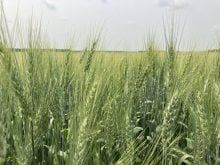Corn tar spot fungus is proving to be a growing threat to corn producers in Canada and the United States.
The fungus was first detected in Mexico in 1904, spread throughout Central and South America then made its way into Illinois and Indiana in 2015. It spread across the U.S. corn-growing region and arrived in Ontario in 2020.
Tar spot is caused by the fungal pathogen Phyllachora maydis. According to the Crop Protection Network, it can be diagnosed by examining corn leaves for the presence of small, circular, black, tar-like spots. They have a slightly raised appearance, feel bumpy and cannot be wiped off. They are often seen after silking through to late grain filling but could be seen earlier and they have been observed on both green leaves and aged tissue.
Read Also

Volatile temperatures expected for this winter
DTN is forecasting a lot of temperature variability in the Canadian Prairies this winter. Precipitation should be close to average.
Tar spot infection develops during cool temperatures and high humidity, such as frequent cloudy days and long periods (seven hours plus) of leaf wetness due to rain, fog, or high humidity.
Irrigation can put corn at greater risk because overhead irrigation can increase the duration of leaf wetness.
Tar spot is an example of the disease triangle when a susceptible host, an aggressive pathogen and a conducive environment create the right conditions for disease.
If wet conditions persist, tar spot can continue to infect and produce more spores. Those are then dispersed, infect more corn and, within a few weeks, produce yet more spores.
The challenge for farmers is that the fungus reduces yield because the loss of leaf area as a result of spotting lessens the leaf’s photosynthetic capability. It can also cause leaves to prematurely die. When environmental conditions are right, tar spot infection can result in 100 percent loss of yield.
In the United States, tar spot infestations resulted in an estimated yield loss of 242 million bushels from 2018-20.
To mitigate the growing threat of the fungus, 22 plant pathologists from 12 institutions compiled a recovery plan, reviewing current knowledge and the future expectations of yield loss from tar spot when environmental conditions are right.
“This disease highlights the importance of state-based land grant university extension plant pathologists, who worked together to enable communication across state lines in tracking this disease,” said Darcy Telenko, assistant professor, Botany and Plant Pathology at Purdue University in Indiana.
She said the disease is causing significant yield losses and continues to spread through the U.S. and Canada.
“The fungus produces round to irregular, raised black structures called stromata in infected tissue, which is where it gets the name tar spot,” said Telenko. “It is favoured by long periods of leaf wetness. Once the disease is present in a field, high moisture conditions such as rain, relative humidity and long dew periods will cause it to increase.”
The team consisted of plant pathologists across North America and they relied on the development of new technology to monitor the onset of tar spot and its progress in real time.
“We have developed a few new tools to help monitor and track the disease including ipmPIPE maps (https://corn.ipmpipe.org/tarspot/) and the Tarspotter app, at https://ipcm.wisc.edu/apps/tarspotter/,” she said.
The app helps to determine if environmental conditions are favourable for tar spot.
The map records every county or region where the disease occurred and the date of its first appearance. It shows the spread of the disease into Ontario, Pennsylvania, Georgia, Florida and Nebraska.
Telenko said fungicides can help manage the problem and efficacy tables are available through the Crop Protection Network (www.cropprotectionnetwork.org) for the most common diseases in corn. It will be updated in 2022.
It is unclear how the pathogen first arrived in the U.S., but it may have been carried in on a tropical storm. Since its arrival, it has been found that it is able to overwinter.
“We have determined the pathogen does survive in infested residue, allowing it to persist for multiple years,” she said. “But it is still unclear as to the length of survival in debris or if the pathogen can survive in soil.”
To get ahead of an infestation, the team continues to work on developing best management options.
“The practices we suggest include regular and constant scouting to understand the risk in the fields, reduce residue to lower disease spread, use moderate resistant hybrids, use mixed modes of action when applying fungicides, and (be aware) that fungicide timing is critical. Leaves need to be protected before tar spot might appear.”
Fungicide stewardship will be critical to ensure that fungicide resistance does not develop.
“Only in 2021 did our research trials show a benefit of two applications (of fungicide) with a follow-up application three weeks later,” she said.
“In 2019 and 2020 we did not see a benefit of a second fungicide application. That is why it is important to monitor and scout. It is not cost-effective to apply fungicide every year. I suggest being flexible and understand how severe the disease has been on your farm.”
The scientists plan to continue to research fungicide efficacy and timing, refine the Tarspotter model, look at impacts of irrigation as well as work on a variety of projects to reduce the effects of the pathogen on corn.
Recent examples of a tar spot epidemic in Indiana in 2021 underscored that the severity of the infestation will be a function of the weather, the hybrid nature of the corn and its level of disease resistance, and when an epidemic starts (earlier or later in the growing season).
Telenko said crop rotation might help but is not a sole solution and tillage may help reduce or delay the onset of the disease by reducing residue.
“I will worry about the disease starting early if we have a wet June and July like we did in 2021,” she said. “In Indiana, tar spot has been an annual concern since 2018 when growers experienced 20-60 bu. an acre loss. This past 2021 season, favourable weather conditions led to another severe epidemic where there were reports of fields experiencing 50 percent reduction in yields across the Midwest.
“Tar spot has continued to spread and has now been confirmed in 82 of 92 Indiana counties, 14 states, and Ontario. Once in a region, we really can’t halt the infestation since the spores can move on weather systems. We need to utilize integrated disease management tools.”
The report was published in Plant Health Progress.















